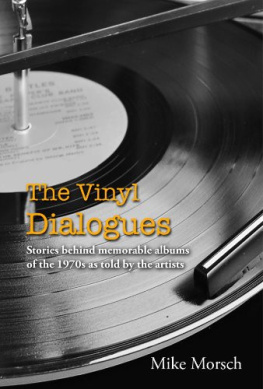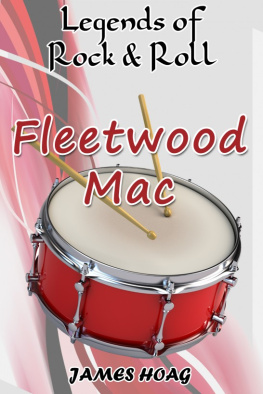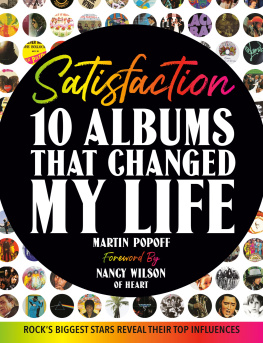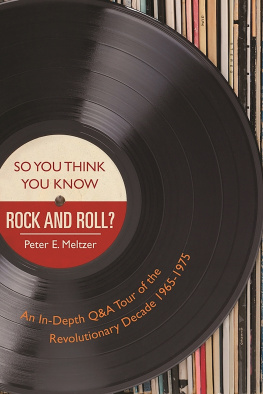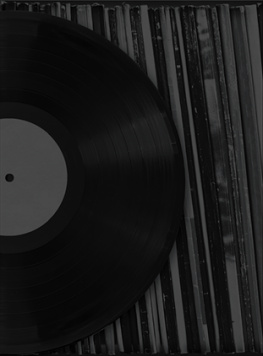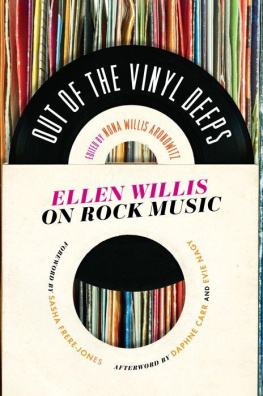The Vinyl Dialogues
Stories behind memorable albums
of the 1970s
as told by the artists
by Mike Morsch
Copyright 2014 Mike Morsch
For my mom and dad,
who had a great vinyl collection.
Cover design by Ron Dacanay.
Editing by Frank D. Quattrone and Ruth Littner and Ann Stolinsky of Gemini Wordsmiths.
ISBN: 978-1-62249-210-7
Library of Congress Control Number: 2014908973
Published by
Biblio Publishing
BiblioPublishing.com

If you like this book, Click Here to write your own review on Amazon.com!
The Vinyl Dialogues Volume II: Dropping the Needle on more albums of the 1970s

The second book in The Vinyl Dialogues series by award-winning journalist Mike Morsch features interviews with classic rock artists such as John Oates of Hall & Oates, Bruce Johnston of the Beach Boys, Don Felder of the Eagles, Elliot Easton of the Cars, Clem Burke of Blondie, Artimus Pyle of Lynyrd Skynyrd, Jerry Martini and Greg Errico of Sly & the Family Stone, Darlene Love, Rich Williams of Kansas, Shelia Ferguson of The Three Degrees, B.J. Thomas, Maureen McGovern and many more. Through these interviews, The Vinyl Dialogues Volume II: Dropping the Needle , chronicles the behind-the-scenes stories of the making of memorable albums of the 1970s directly from the artists who created the music. So get the inside scoop on some great stories, then dig into your record collection, lay down some vinyl and drop the needle on a decade of remarkable music, or pick up your phone, and pop in your ear buds.
For a free preview chapter, featuring Southside Johnny and the Asbury Jukes, CLICK HERE .
Contents
Everything old is new again
Introduction
Mike Morsch
When I was a kid growing up in central Illinois, my folks had a record collection that consisted of popular music from the late 1950s to the mid-1960s. I played those vinyl albums Elvis, The Beach Boys, The Beatles, The Association, and many more so much that I wore them out.
By the time the 1970s rolled around and I was in high school, I was more into eight-track tapes, cassettes, big bushy sideburns, and bell-bottomed pants. (Seventies suave indeed.)
And I still didn't have my own record collection.
More than 35 years later I decided to change that. For Christmas 2013, my wife got me a turntable because I told her I was going to start a record collection. The premise was that I wanted to hear the early work of some of my favorite artists, and my thinking was that listening on vinyl would offer me the purest form of the music.
This hobby developed into a labor of love for me.
I spent time researching a band and its music, chose an album I thought Id like to have in my collection, and went to the record store in search of the album. Fortunately, there are still a few record stores around my part of southeastern Pennsylvania, and theres a certain nostalgic charm about going into one and searching through the albums.
The first album I coveted was Abandoned Luncheonette by Daryl Hall & John Oates. I suspect that since I didnt grow up on the East Coast, I was unaware of the early Hall & Oates stuff because they didnt have country-wide recognition back then. So I had never really heard the entire album as a single body of work.
Anyone whos a treasure hunter of sorts be it at an antique store, garage sale, or baseball card show knows that feeling of elation upon actually finding that one thing youve been searching for, and thats what happened to me with Abandoned Luncheonette .
It was sitting in plain sight in one of the bins, and I spotted it instantly as I walked through the door of The Vinyl Closet, a quaint little record shop on Main Street in North Wales, Pennsylvania, owned by Jason McFarland.
I bought the album for $1; it was in fabulous shape. Naturally, I rushed home to play it on my new turntable and I was immediately transported back to the early 1970s in my mind. I was listening to the origins of what is now known as Philly soul or the sound of Philadelphia, and it was, and is, a really cool vibe.
As I was examining the cover art, I flipped the record over and read the information on the back. There, at the bottom in small print, were the words, 1973 Atlantic Recording Corporation.
Hey , I thought to myself, 2013 is the 40th anniversary of the release of that album. I wonder if Daryl and John would want talk about it?
I emailed Jonathan Wolfson, the manager for Hall & Oates, and he responded the same day saying he thought that a story about the 40th anniversary of Abandoned Luncheonette was a great idea and that he would make Daryl and John available for interviews.
Within a week I had both artists on the phone in separate interviews for a story that I was writing for my news organization at the time, Montgomery Media, in Fort Washington, Pennsylvania. Both Daryl and John shared their recollections about making Abandoned Luncheonette and the story of how they got the now-famous photographs that grace the front and back covers of the album, those of a forgotten diner that once rested on the outskirts of Pottstown, Pennsylvania, just off Route 724, not far from where I live.
The Hall & Oates interviews were so fun and informative that I began to wonder if others artists from the 1970s would talk about their experiences and recollections of making specific albums.
And thats how the idea for this book was born. All I needed to do was execute.
I asked other favorite musicians; they answered Yes!
And thats what youll read about here those memorable stories from the artists who made such brilliant music in the 1970s in The Vinyl Dialogues .
It all started because I found an album at a local record store for a dollar, took it home and listened to it, and discovered the early sounds of Philly soul.
And everything old is new again.
Mike Morsch
We were lazy slobs;
we didnt work at it
Burrito Deluxe
The Flying Burrito Brothers
It had all started out so well for The Flying Burrito Brothers. And those good feelings continued into the early recording of their second album, Burrito Deluxe . But before the completion of Burrito Deluxe , The Flying Burrito Brothers were starting to lose it. One of the reasons was that guitarist Gram Parsons was having trouble staying focused on the music he was creating, because he was infatuated with Keith Richards.
The groups first album, The Gilded Palace of Sin , released in 1969, had helped cement the reputations of Parsons and Chris Hillman two of the original members of The Byrds as innovators in what was then the early stages of a new genre, country rock.
The original Flying Burrito Brothers Parsons, mandolin player Hillman, bassist Chris Ethridge, and pedal steel guitarist Sneaky Pete Kleinow was founded in 1968. After The Gilded Palace of Sin was released, the band hired another ex-Byrds member, drummer Michael Clarke, and lost Ethridge, who was replaced by Bernie Leadon. In 1970, the reshuffled lineup set out to record its second album, Burrito Deluxe . In the two and-a-half years since Parsons and Hillman had left the Byrds, and up to the recording of Burrito Deluxe , almost everything had been going smoothly between the two collaborators. Then Gram Parsons met Keith Richards.
Gram was starting to lose interest and was hanging out a lot with Keith, said Hillman. Thats how we ended up with the song Wild Horses. Written by Richards and Mick Jagger of the Rolling Stones, Wild Horses was the 11th and final song cut by the Burritos for Burrito Deluxe .
Next page
